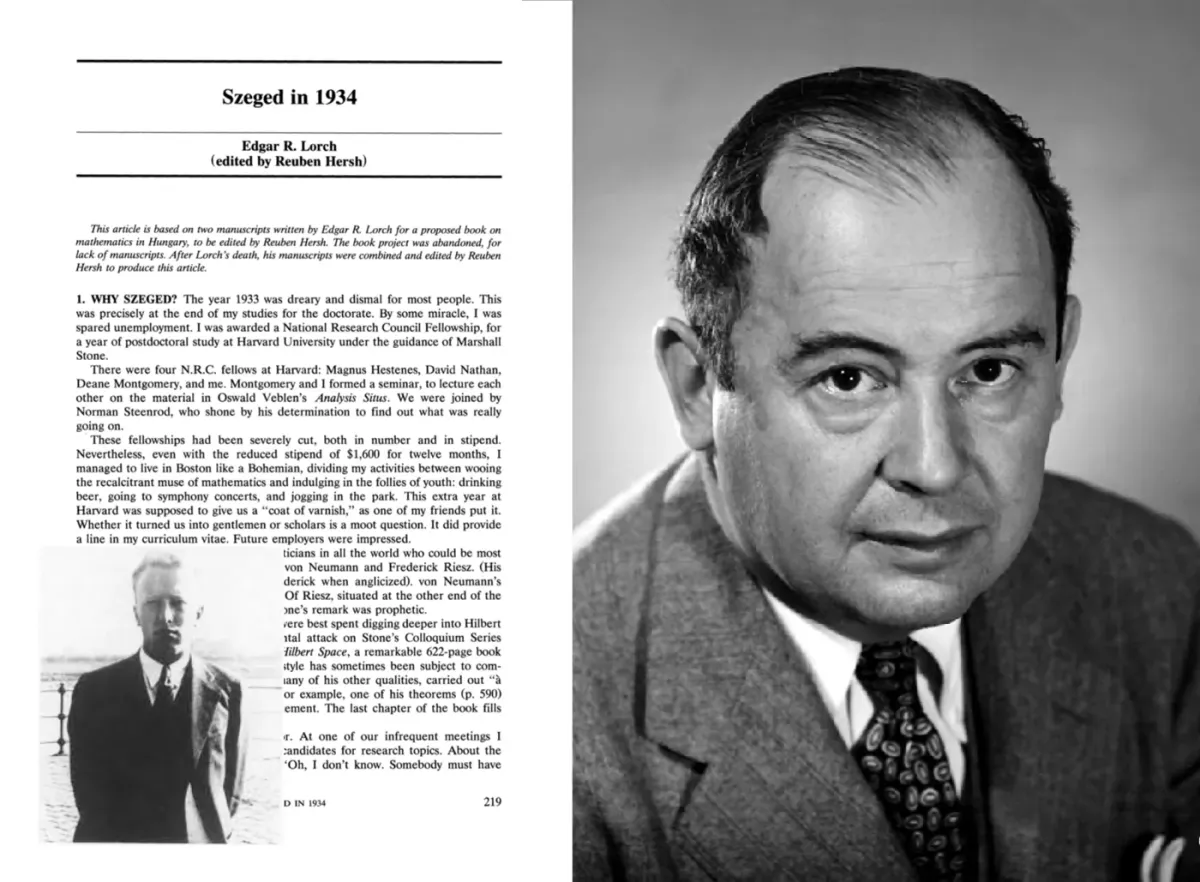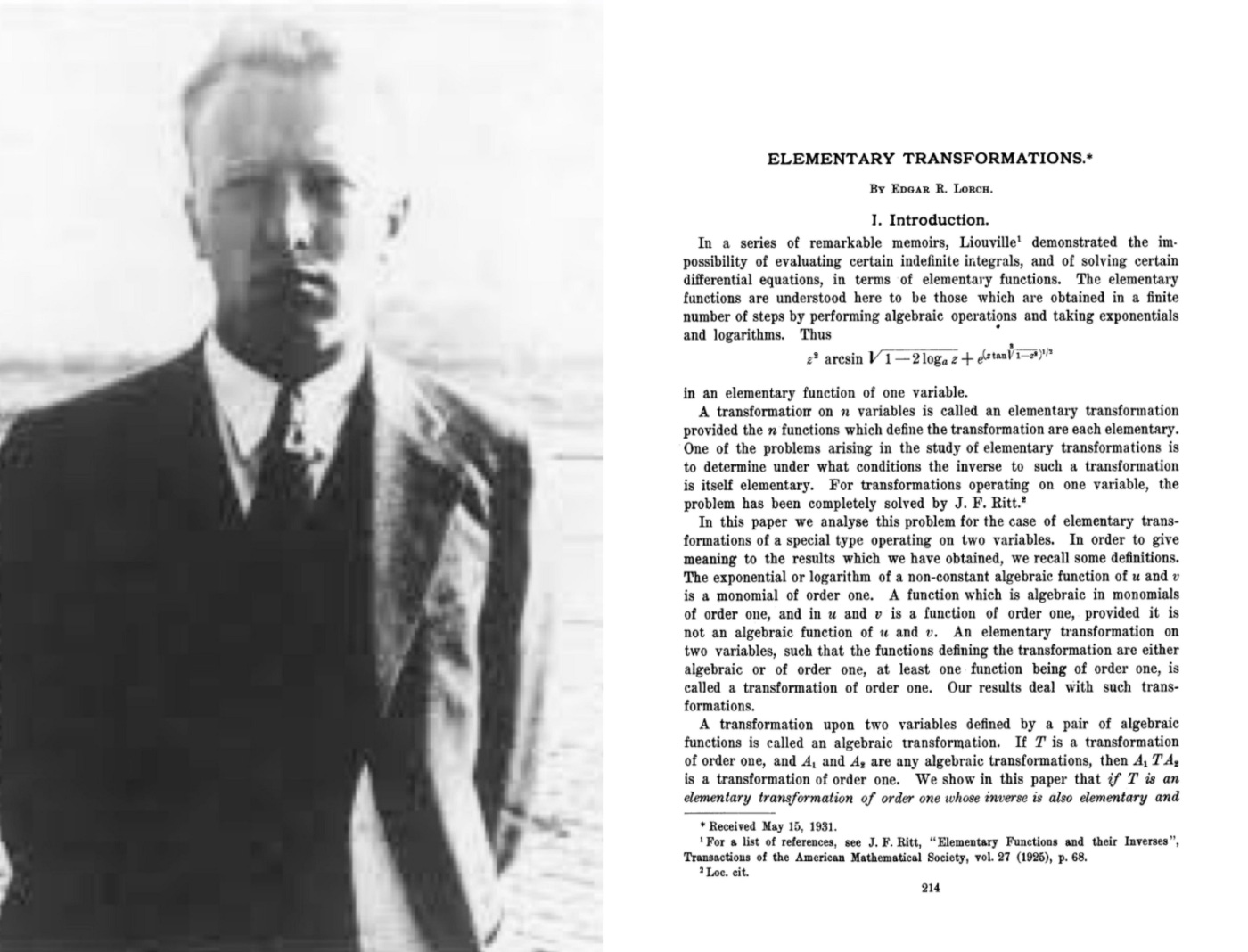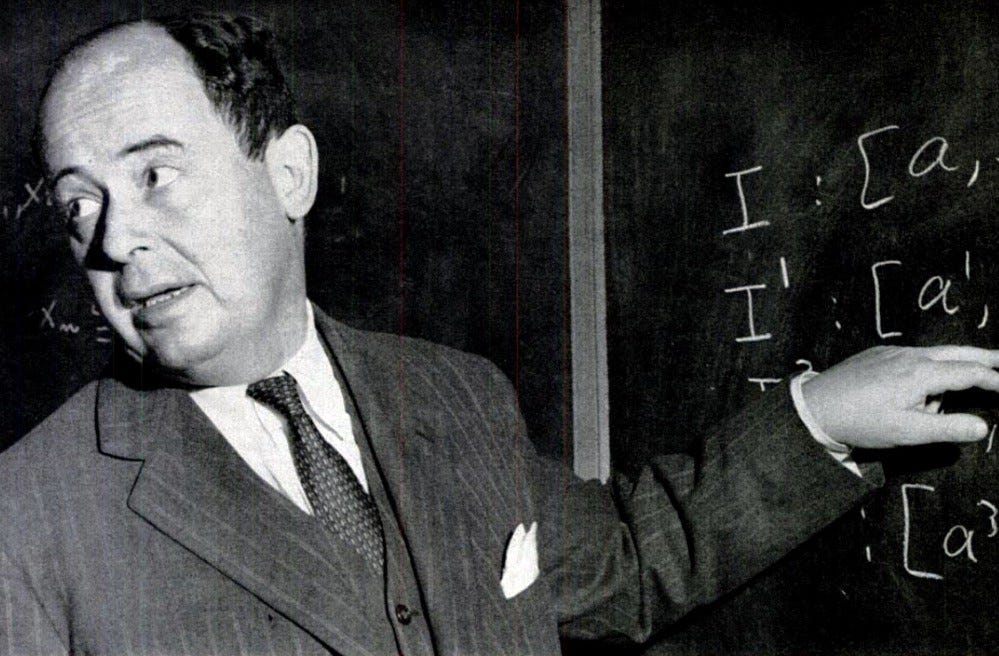The Duties of John von Neumann’s Assistant in the 1930s
The year is 1933. A 26 year-old former graduate student at Columbia University, Edgar R. Lorch (1907–1990) has just completed his Ph.D. in mathematics and is, in his own words “by some miracle” awarded a National Research Council Fellowship for a year of postdoctoral studies at Harvard University.

"The job entailed such onerous duties that only someone with an iron constitution could survive. My constitution, it so happened, was not made by iron. It was made of reeds and bamboo sticks"
The year is 1933. A 26 year-old former graduate student at Columbia University, Edgar R. Lorch (1907–1990) has just completed his Ph.D. in mathematics and is, in his own words “by some miracle” awarded a National Research Council Fellowship for a year of postdoctoral studies at Harvard University. Worried that the ongoing Great Depression will leave him unemployed, as the fellowship nears its end Lorch applies for a one-year extension to visit Princeton and study under Professor John von Neumann (1903–1957) at the Institute for Advanced Study.
Becoming von Neumann’s Assistant
Lorch’s Ph.D. thesis entitled “Elementary Transformations” had regarded Joseph Liouville (1809–1882)’s result showing the “impossibility of evaluating certain indefinite integrals, and of solving certain differential equations, in terms of elementary functions”. Elementary functions, Lorch defined as “those which are obtained in a finite number of steps by performing algebraic operations and taking exponentials and logarithms”. One of the results of his thesis was later published in the Annals of Mathematics 33(2) under the same title.

For his fellowship, Lorch had been assigned supervisor Marshall H. Stone (1903–1989). An American mathematician working in real and functional analysis, Stone had been the author of the epic work Linear Transformations in Hilbert Space, a 622-page extensive treatment of the subject which Lorch would later comment was “more often quoted than read”.
“Stone had a special sense of humour. At one of our infrequent meetings I mentioned some problems as possible candidates for research topics. About the best one of my problems, Stone said, “Oh, I don’t know. Somebody must have worked on that problem already”. The following week, while browsing in Widener Library, I came upon an article containing the complete solution to the problem. The author: M. H. Stone.” — Edgar R. Lorch
As Lorch recounts, together with Stone the two agreed that his fellowship would be best spent learning more about Hilbert and Banach spaces. This would invariably involve a “frontal attack on Stone’s […] Linear Transformations in Hilbert Space”. Stone noted to Lorch that the two mathematicians in the world who could be most helpful in his development at the time (in addition to himself) would be Frederick Riesz (1880–1956) and von Neumann. Riesz was a Hungarian mathematician Lorch had never heard of who lived “on the other side of the world” in Hungary. von Neumann of course, although also Hungarian, was a few short hours’ train ride away from Cambridge at the IAS in Princeton.
Lorch’s NRC fellowship was for $1,600 for twelve months (about $31,400 when adjusted for inflation). The stipend enabled him to live in Boston “like a Bohemian” while being given the necessary Harvard “coat of varnish” needed to impress future employers. As the year went on—largely due to the ongoing great depression—Lorch however worried that it would not be enough. And so, he applied for a one-year extension to the National Research Council to visit von Neumann the Institute for Advanced Study:
“I gingerly went home, and sure enough, there was a letter from the Institute. The type-print covered the whole page — success! I would be able to live another year.”
Lorch had been offered a position as the assistant to—perhaps, the smartest person who ever lived—John von Neumann. As he writes, “in order to further distinguish [professors at the Institute for Advanced Study] from ordinary mortals teaching at Columbia, Yale, and other universities, each professor [at the IAS] had an assistant”. Although Lorch had seen von Neumann lecture several times, he did not know him personally. He did however recall a glorious episode of meeting von Neumann at a party, where the latter had ended up in a recitation race (von Neumann had an eidetic memory) with Norbert Wiener (1894-1964) of MIT:
“Somehow, someone recited a line from Lewis Carroll’s “The Hunting of the Snark”. Norbert Wiener with his usual ebullience and sonorous voice, began reciting from line 1. Johnny started off in pursuit. Norbert accelerated, but Johnny came up even. We held our breaths as the lines poured out, on and on until they reached the end in a dead heat”
Both child prodigies, Wiener had been “trained” by his father Leo from an early age, including in Greek and Latin classics and Germany poetry, starting at the age of five. von Neumann conversant in Ancient Greek at age six and was reading Emile Borel’s Théorie des Fonctions (“On some points in the theory of functions” ) at age twelve (Leonard, 2010).
Duties of von Neumann’s Assistant
Thrilled to learn of the offer from the Institute, Lorch made the trip to Princeton to meet with Oswald Veblen (1880–1960), its Director at that time.
“What,” asked I, “are the duties of an assistant to Professor von Neumann?”
Professor Veblen’s reaction, according to Lorch, was to
“Answer with a mixture of surprise and distain, that a mere private second class should ask such a question about a four star general.”

Veblen nevertheless eventually gave an answer. The following were the four principal duties of von Neumann’s assistant in the 1930s:
- To attend von Neumann’s lectures and take copious notes, complete unfinished proofs, see them through the secretarial jungle, and promptly circulate them to all American university libraries.
Von Neumann lectured on operator theory. His lectures were on Mondays, Tuesdays and Wednesdays. Lorch writes that keeping up with the brilliant professor on this task alone amounted to “consuming the entire energies of a younger person, who had to be not only well-meaning but sharp, fast, clever and tough.”
“The notes ran to over 600 pages. Weekly.”
One of von Neumann’s brothers later described audiences’ difficulties in keeping up with the great man’s lectures in the following way:
"His fluid line of thought was difficult for those less gifted to follow. He was notorious for dashing out equations on a small portion of the available blackboard and erasing expressions before students could copy them."
— Excerpt, John von Neumann: As Seen by his Brother by N.A. Vonneuman (1987)
- To translate in to English von Neumann’s numerous 100-page papers.
Because von Neumann (by 1933) was working for an American institution, it was expected that the Professor’s papers would appear in English (not German, as most of his previous papers had). As such, rather than von Neumann going through the strain of writing in English, his assistant was given the task of translating his works on his behalf.
- To be von Neumann’s assistant as Editor of the Annals of Mathematics. This meant reading through every manuscript accepted for publication, underlying Greek letters in red and German letters in green, and circling italics. Also writing in the margins all necessary instructions to printers.
Lorch describes the “hazards of being an editorial assistant of the Annals of Mathematics in the 1930s” by way of the following anecdote about a manuscript submitted by Soviet mathematician Lev Pontryagin (1908–1988):
“[Because] paper was then exceptionally scarce in the Soviet Union, Pontryagin had taken wrapping paper, torn it into appropriate-sized pieces, and gone to work on his typewriter. Unfortunately, Pontryagin was blind. The wrapping paper was torn unevenly, and a good portion of the words and symbols in the margins were missing.“
“No matter, the Annals of Mathematics editorial assistant retyped the letter, supplying all the missing symbols.”
- To go once a week to the printers of the Annals of Mathematics in Baltimore in order to instruct them in the art of typesetting mathematical symbols with subscripts, superscripts, subsubscripts, etc.
The Annals had traditionally been printed in Hamburg, Germany but due to increasing anti-semitism had moved printing to Baltimore in the United States. As American printers were not yet accustomed with the practice of typesetting mathematical symbols, they needed to be taught.
As Lorch later recalled,
“I left my meeting with Veblen in a downcast mood”
However, as it would turn out, salvation was near:
A few days after returning to Cambridge, I received a letter from the Dean of the Graduate School at my alma mater, Columbia University. The contents made me radiant. In view of my "outstanding work in scholarship and research," the letter said, I had been awarded a Cutting Traveling Fellowship for the following academic year.
There were no conditions on the award, except to use it for travel, presumably in Europe. The stipend was for $1,800 (more than I was currently receiving as a National Research Council fellow). What should I do?
[...]
Here I had the opportunity to work next to the most brilliant mathematician of his generation. But the job entailed such onerous duties that only someone with an iron constitution could survive. My constitution, it so happened, was not made by iron. It was made of reeds and bamboo sticks, very satisfactory under moderate pressures, but completely incapable of standing a huge overload.
[...]
I already had in mind the professor whom I wanted to visit: Frederick Riesz of Hungary - the man suggested by Professor Stone. Riesz worked in a town I had never heard of, Szeged. I went to my atlas and found it: the second city in Hungary. There was a university: Ferencz-Jozsef Tudomány Egyetem. I was mouthing my first words in a strange new language.
[...]
The die was cast. Off to Szeged!
— Excerpt, "Szeged in 1934" by Edgar R. Lorch, edited by Reuben Hersh
Lorch went on to have a productive year in Szeged and develop an exceptionally good relationship with Riesz:
The optimal relation between a mentor and his disciple is seldom achieved. The relation between Riesz and me was optimal. It was warm, intimate, continuous, without pressure, very calm, leaving each of us free to develop his own thoughts.
My stay with him was a perfect amalgam of a healthy, pleasurable life and an uninterrupted communication of mathematical ideas. Access to mutual discussion was free, but never overused. Frigyes Riesz was indeed a perfect teacher and a warm companion.
— Edgar R. Lorch.
This essay is based on the article “Szeged in 1934”, which was compiled by Reuben Hersh from two manuscripts of Lorch’s for a proposed book on mathematics in Hungary. The article was later published as:
- Lorch, E.R. (1993).Szeged in 1934. The American Mathematical Monthly 100 (3). pp. 219–230.





